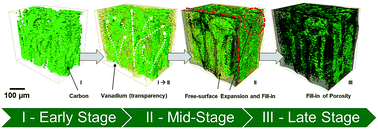当前位置:
X-MOL 学术
›
Sustain. Energy Fuels
›
论文详情
Our official English website, www.x-mol.net, welcomes your
feedback! (Note: you will need to create a separate account there.)
Uncovering the mechanisms of electrolyte permeation in porous electrodes for redox flow batteries through real time in situ 3D imaging
Sustainable Energy & Fuels ( IF 5.0 ) Pub Date : 2018-07-20 00:00:00 , DOI: 10.1039/c8se00174j Farid Tariq 1, 2, 3, 4, 5 , J. Rubio-Garcia 3, 4, 5, 6 , Vladimir Yufit 1, 2, 3, 4, 5 , Antonio Bertei 7, 8, 9, 10 , Barun K. Chakrabarti 1, 2, 3, 4, 5 , Anthony Kucernak 3, 4, 5, 6 , Nigel Brandon 1, 2, 3, 4, 5
Sustainable Energy & Fuels ( IF 5.0 ) Pub Date : 2018-07-20 00:00:00 , DOI: 10.1039/c8se00174j Farid Tariq 1, 2, 3, 4, 5 , J. Rubio-Garcia 3, 4, 5, 6 , Vladimir Yufit 1, 2, 3, 4, 5 , Antonio Bertei 7, 8, 9, 10 , Barun K. Chakrabarti 1, 2, 3, 4, 5 , Anthony Kucernak 3, 4, 5, 6 , Nigel Brandon 1, 2, 3, 4, 5
Affiliation

|
Increasing energy demands have expedited the need for grid-scale energy storage solutions. High power densities have been achieved using carbon-based electrodes in all-vanadium redox flow batteries. However, fundamental limitations must be overcome to improve viability. This study addresses the infiltration of vanadium solutions into dry electrodes using time-resolved 3D X-ray tomography, thus relating the rate of permeation and other wetting phenomena to microstructural characteristics and surface properties of carbon fibers. It is shown that electrolyte infiltration proceeds according to a non-uniform progression front, with small channel-like pores filled in first and remaining larger pores filled only after 6 h. The vanadium concentration affects the infiltration rate, being faster for 0.5 M VOSO4 while slower for both higher and lower concentrations. The infiltration mechanism is strongly correlated with the temporal decrease in the contact angle, revealing that fibers become more hydrophilic as they are treated by the electrolyte solution. Modification of carbon surface groups through plasma treatment boosts the infiltration process. The results reveal counter-intuitive behaviors of the electrolyte flow whereby the capillary driven flow is found to be secondary to the primary wetting mechanisms. Uncovering these physical phenomena is essential for operational procedures in flow batteries and avoiding cell degradation.
中文翻译:

通过实时原位3D成像 揭示氧化还原液流电池的多孔电极中电解质渗透的机制
不断增长的能源需求加快了对电网规模的储能解决方案的需求。使用全钒氧化还原液流电池中的碳基电极可实现高功率密度。但是,必须克服基本限制以提高生存能力。这项研究使用时间分辨3D X射线断层摄影技术解决了钒溶液浸入干电极中的问题,从而将渗透速率和其他润湿现象与碳纤维的微观结构特征和表面特性相关联。结果表明,电解质的渗透是按照不均匀的过程进行的,先是小通道状的孔被填充,其余的较大的孔仅在6小时后被填充。钒浓度会影响渗透速率,对于0.5 M VOSO 4来说更快而对于较高和较低的浓度,速度都较慢。渗透机理与接触角的暂时减小密切相关,这表明纤维在被电解质溶液处理后变得更加亲水。通过等离子处理对碳表面基团的改性促进了渗透过程。结果揭示了电解质流的反直觉行为,由此发现毛细管驱动的流次于主要润湿机制。发现这些物理现象对于液流电池的操作程序和避免电池性能下降至关重要。
更新日期:2018-07-20
中文翻译:

通过实时原位3D成像 揭示氧化还原液流电池的多孔电极中电解质渗透的机制
不断增长的能源需求加快了对电网规模的储能解决方案的需求。使用全钒氧化还原液流电池中的碳基电极可实现高功率密度。但是,必须克服基本限制以提高生存能力。这项研究使用时间分辨3D X射线断层摄影技术解决了钒溶液浸入干电极中的问题,从而将渗透速率和其他润湿现象与碳纤维的微观结构特征和表面特性相关联。结果表明,电解质的渗透是按照不均匀的过程进行的,先是小通道状的孔被填充,其余的较大的孔仅在6小时后被填充。钒浓度会影响渗透速率,对于0.5 M VOSO 4来说更快而对于较高和较低的浓度,速度都较慢。渗透机理与接触角的暂时减小密切相关,这表明纤维在被电解质溶液处理后变得更加亲水。通过等离子处理对碳表面基团的改性促进了渗透过程。结果揭示了电解质流的反直觉行为,由此发现毛细管驱动的流次于主要润湿机制。发现这些物理现象对于液流电池的操作程序和避免电池性能下降至关重要。











































 京公网安备 11010802027423号
京公网安备 11010802027423号